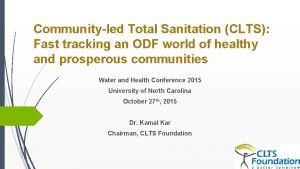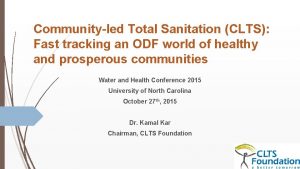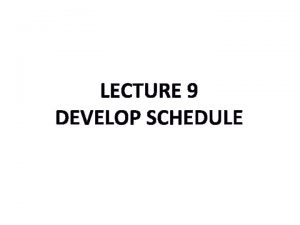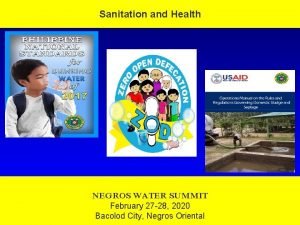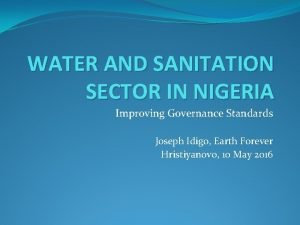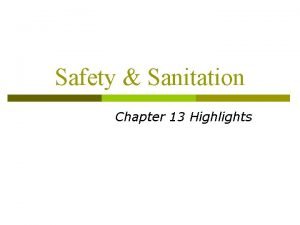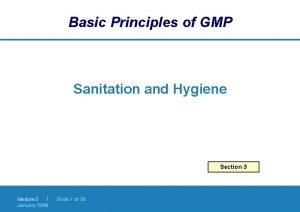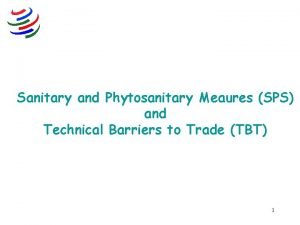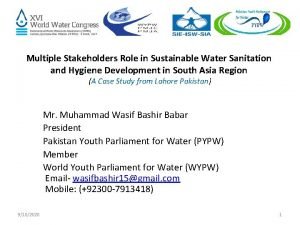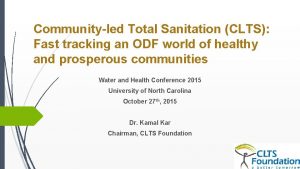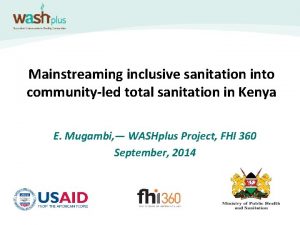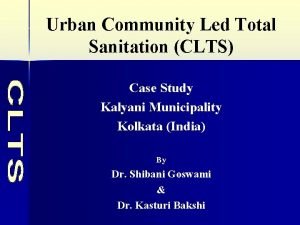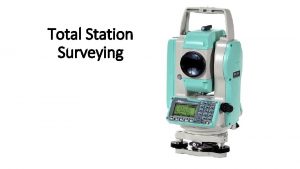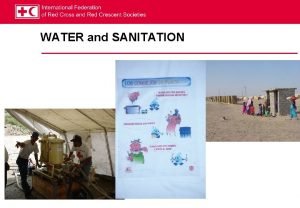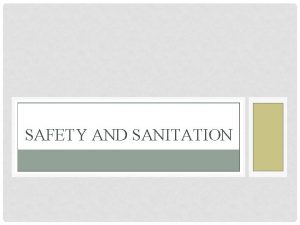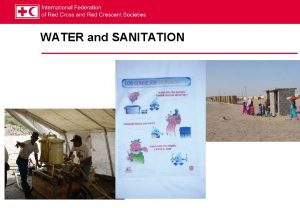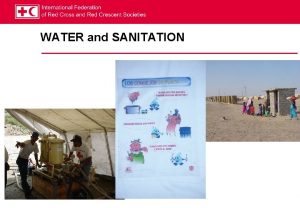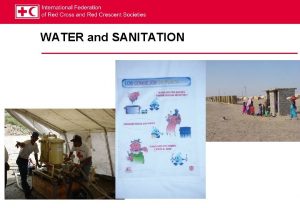Communityled Total Sanitation CLTS Fast tracking an ODF
























- Slides: 24

Community-led Total Sanitation (CLTS): Fast tracking an ODF world of healthy and prosperous communities Water and Health Conference 2015 University of North Carolina October 27 th, 2015 Dr. Kamal Kar Chairman, CLTS Foundation

Sanitation and the MDGs The recognition of sanitation as a key element in health outcomes started fairly late in international development Focus was largely on individual hygiene and sanitation. The understanding of “total sanitation” spanning full communities came much later Many countries have achieved their MDG water targets yet lag far behind in sanitation. In fact the progress on Goal no 7 (sanitation) has been very poor by most countries in Africa and Asia, which is one of the worst performing goal during the MDGs. Why is this ?

Sanitation and the MDGs Through most of the MDG period especially at the beginning, a compartmentalised and traditional approach to water and sanitation continued to prevail. In the mid/latter part of the MDG period the global sanitation community and national leaders started realising that the top down traditional approach of providing toilet as infrastructure to individual households was not yielding the desired results. This shift in thinking was triggered by the emergence of CLTS Pioneered in 2000 in Bangladesh Spread exponentially throughout countries in Africa, Asia and Latin America.

Sanitation and the MDGs Led to shift in policy thinking and practice. Towards the middle of the MDG period many countries started adopting CLTS. Outcome : 40 million people gained access to sanitation through CLTS and experienced first hand improvements in basic sanitation reflected in distinct health outcomes. Some patches of the high endemic zones of cholera, diarrhoea and other enteric diseases started declaring ODF and reported total eradication of these diseases in villages and districts etc. There has also been a reported case of absence of Ebola in 69 ODF zones in Liberia ( this needs more scientific investigation though).

2, 469, 966 ODF Population Eastern and Southern Africa Total ODF Population: ~7. 6 Million 1, 308, 000 Namibia, Botswana and Lesotho recent initiation of CLTS 1, 026, 800 639, 300 544, 319 430, 000 227, 507 ia hi op Et bi a m Za ny a Ke M al aw i ue M oz am Er bi q itr e a i Bu ru nd r ca ag as M ad go la da 121, 015 An m ga n U ut h So So n Su da e bw ba m Zi al ia 10, 000 1, 675 59, 400 50, 000 241, 755

Open defecation free communities Since 2010

MDGs and CLTS EARLY ADOPTERS OF CLTS : Open defecation rates OD Reduction Year of (RURAL) rate Introduction 1990 2015 Bangladesh 34 1 33 2000 Cambodia 94 60 34 2005 Ethiopia 100 34 66 2006 Pakistan 67 21 46 2004 Indonesia 49 29 20 2005 Source: WHO-UNICEF JMP Report (2015 ) Met MDG target Exceptional case

MDGs and CLTS COUNTRIES THAT ADOPTED CLTS HALF-WAY THROUGH MDGs : Open defecation rates (RURAL) OD Reduction rate (RURAL Year of Introduction 1990 2015 Kenya 22 15 7 2007 Malawi 33 5 28 2008 Vietnam 43 1 42 2008 Madagascar 60 52 8 2008/2011 Mali 37 15 22 2009 Myanmar 4 2010 Thailand 10 0 10 2010 Source: WHO-UNICEF JMP Report (2015 ) Met MDG target Exceptional case

MDGs and CLTS COUNTRIES STILL STRUGGLING Open defecation rates (RURAL) 1990 2015 India 91 61 Benin 95 76 Burkina Faso 89 75 Chad 93 79 Cote d'Ivoire 56 51 Source: WHO-UNICEF JMP Report (2015 ) Comments First country after Bangladesh. However stiff resistance to no-subsidy and mixed policy has stifled progress. India contributes to 58% of world's OD First introduced in 2009. Reintroduced in 2014. In one year more than 800 localities were made ODF Though one of the earlier adopters in Western Africa, CLTS has been mainstreamed into national policy only as recently as 2014 Introduced in 2009, but mainstreamed only after 2012 Introduced in late 2000 s, but mainstreamed only much later

Sanitation and Child health COUNTRY STATUS Proportion of the 2015 population that gained access since 1990(%) IMR CMR U-5 Mortality Rank MET WATER TARGET LITTLE or NO PROGRESS IN SANITATION Guinea-Bissau 59 0 78 124 6 Mali 64 18 78 123 7 Nigeria 48 9 74 117 9 Burkina Faso 61 16 64 98 14 Benin 52 17 56 85 24 Ghana 59 11 52 78 28 Djibouti 39 4 57 70 36 India 46 28 41 53 47

Sanitation – Health linkages The lack of sanitation has not only neutralised the full impact of ensuring access to water but has also caused more harm in some places where water came with basic improvement on sanitation. It has been proven clearly that success in enhancing water access or other development objectives will not result in health outcomes until the MDG 7 is achieved. Unless sanitation is improved. Nutrition programmes are often ineffective because most of the nutrient is not absorbed by the GI tract that looses absorption capacity due to repeated bouts of diarrhoea.

Sanitation – Health linkages Impact on stunting, wasting, malnutrition are alarming!! Statistics are available from different countries Impact on human health due to the practice of OD especially caused by the NTD and Zoonotic diseases are enormous. Economic loss from livestock production is also huge. Insanitary condition affect women's health in terms of anemia and adverse pregnancies. Also threat and risks of violence endangers their overall wellbeing Strong link between NTD and sanitation has been proven

CLTS - Paradigm Shifts in Policy and Practice Focus of Intervention Construction of toilet Collective behaviour change Technology Top down technology prescription Local empowerment Extent of Coverage Partial coverage Total (ODF environment) Monitoring Indicator Counting latrines Counting ODF communities Leadership Technocrats Political actors


Impact of CLTS on Health outcomes CLTS has demonstrated success in increasing access to sanitation enhancing greater coverage, faster uptake by the community due to internalised behaviour change leading to more sustainable outcomes. CLTS through better sanitation outcomes have led to better health and reduced medical expenditure and more productivity of ODF communities Evidence of global health impacts of CLTS is fast emerging. Cases of reduced stunting/wasting ( Mali), reduction in cholera ( Kenya, Ghana) are a few examples.

Impact of CLTS on Health outcomes Additionally the knock on effects of CLTS leads to collective gains for the community in terms of health greater collective consciousness of people towards health care environmental cleanliness activating health services and institutions. People start thinking about their overall wellbeing. In the SDGs it is important to see that policy and practice is geared towards achieving ODF nations For this institutions and governance have to become responsive greater political will and commitment Increase budget allocation to sanitation

Impact on Health Nyando Hospital record shows how incidence of diarrhea and cholera dropped dramatically in Niando districts in Kenya – Impact of simple pit latrines on health

Mali – Impact Evaluation 18 One year after intervention in CLTS villages: 26% reduction in stunting ( U-5) 35% reduction in underweight 57% reduction in diarrhoearelated U 5 - mortality

REGIONS IN CHAD ch ar i ai oy en dd is ua M je ad O am Si la r. L at H ar am i No. of latrines(CLTS) Ch C ha ri G Ba ue gu ra Sa irm Si la m (G at H oz B Sila ad e je id r L a) a O M u mis oy ad en da C i ha ri La c 0 G U No. of Latrines before CLTS 5, 000 No. of households rm No. of households 10, 000 Sa l 15, 000 ui 20, 000 A 25, 000 ag 30, 000 18000 16000 14000 12000 10000 8000 6000 4000 2000 0 ER 35, 000 CO-RELATION BETWEEN NUMBER OF HOUSEHOLDS AND LATRINES USED IN ODF VILLAGES OF CHAD i. B CO-RELATION BETWEEN NUMBER OF HOUSEHOLDS AND LATRINES USED IN VILLAGES OF CHAD BEFORE THE IMPLEMENTATION OF CLTS HOUSEHOLDS AND LATRINES IN NUMBERS Direct co-relation of household latrine possession and use in ODF villages in Chad REGIONS IN CHAD CLTS was introduced in September 2009 in Chad ODF villages in serious cholera endemic zones in Chad reported no single case of cholera when other villages were devastated.

Bangladesh: Health and ODF 1995 - 2015 160 100% 90% 140 120 IMR 80% U 5 MR 70% Malnutrition 100 Stunting 80 ODF Pop 50% 40% 60 30% 40 20% 20 10% 0 1985 60% 0% 1990 1995 2000 2005 2010 2015 2020

Some of the major economic, health and social impacts of CLTS Enhanced income Agriculture & Livestock Production Monetary burden of Cystcercosis is > US$ 120 m/year and 200 m Kg of discarded pork in China alone Enhanced Nutrition, improved HALYs including QALYs & DALYs Kamal Kar, WHO Technical Report Series, no. 971, 2012

As we go into SDGs what can we do differently? More holistic approach to sanitation - in policy making, in programming, in implementation Sanitation outcomes have to be measured in terms of health outcomes and not by counting toilets Make sanitation everyone's business - involvement of diverse stakeholders is required Who implements sanitation in nations is important - E. g. in Kenya it is the health ministry Integration of sanitation in health policies/programmes How to help, advocate and capacitate nations and governments interested to move ahead and learn from the success and failures of MDG?

Conclusion Strong linkage of sanitation outcomes on health outcomes is a scientific fact By 2030, even if all other development targets are achieved , lack of attention to sanitation will not yield desired outcomes on health Infant and child mortality will continue to be high How can we change this ? And who will change this ? Are we ready to create an ODF world by 2030 ? - The way we choose to approach the sanitation question in SDGs is critical

Thank You Visit www. cltsfoundation. org for updates and news
 Odf tracking
Odf tracking Odf tracking
Odf tracking Fttx architecture
Fttx architecture Matlab mtex
Matlab mtex Odf
Odf Clts rate schedule
Clts rate schedule The fast tracking method of schedule compression involves
The fast tracking method of schedule compression involves Differentiate between acid fast and non acid fast bacteria
Differentiate between acid fast and non acid fast bacteria Acid fast vs non acid fast
Acid fast vs non acid fast Sanitation importance
Sanitation importance Why is sanitation important
Why is sanitation important Compendium of sanitation systems and technologies
Compendium of sanitation systems and technologies Environmental sanitation clearance
Environmental sanitation clearance Why is sanitation important
Why is sanitation important Drawing of sanitation
Drawing of sanitation Hygiene conclusion
Hygiene conclusion Goof
Goof Concept school
Concept school Gmp sanitation and hygiene
Gmp sanitation and hygiene Sps barriers
Sps barriers National shellfish sanitation program
National shellfish sanitation program Components of environmental sanitation
Components of environmental sanitation Chauteubriand
Chauteubriand Stakeholders in water and sanitation
Stakeholders in water and sanitation Cleaning and sanitation manual for breweries
Cleaning and sanitation manual for breweries
